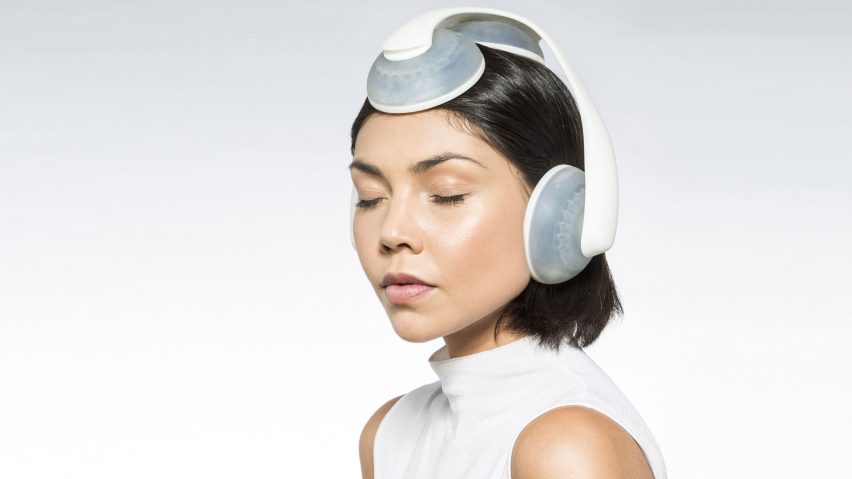Water rather than air carries sound in designer Rocco Giovannoni's Inmergo headphones, which promise rich audio even for people who are hard of hearing.
A 2019 graduate of the Royal College of Art's MA in Design Products, Giovannoni designed the soft silicone headphones to improve upon current bone-conduction audio technology.
Like other bone-conduction headphones on the market, his design bypasses the eardrum and conveys sound as vibrations through the bones of the skull, directly to the cochlea — the "hearing" part of the inner ear.
Unlike any other device on the market, it does so via waterproof speakers that are fully immersed in liquid and then sealed in a pliable membrane. This membrane sits against a person's skin, transmitting sound vibrations through touch.
While existing bone-conduction headphones have proved popular among people who are deaf or have some hearing loss — as well as cyclists who want to listen to music but remain aware of their surroundings — the devices are hampered by poor sound-quality.
"I believe these are wasting an opportunity for a technology that has the potential of improving the music quality of common earphones and headphones," said Giovannoni.
"Inmergo aims to unravel the undiscovered potential of bone conduction by delivering innovative and inclusive sound experiences that can improve the quality of our life."
Inmergo does not quite match the sound experience of traditional headphones; instead, it offers a high-fidelity audio experience that's all of its own.
Giovannoni describes it as "immersive omnidirectional" sound with richer bass. "It feels like you're inside the song," says one wide-eyed subject in Inmergo's user testing video.
Another tester, a deaf person with a unilateral cochlear implant, described it as one of the best listening experiences of her life.
Giovannoni has two functioning prototype models — a two-unit set of headphones and five-unit helmet that wraps more comprehensively around the head. The units are filled with an ultrasonic gel, which the designer chose as the best-sounding fluid after many rounds of testing.
It delivers bass frequencies more efficiently than any air-based design, using just £5 worth of equipment.
Giovannoni hopes to continue developing the patent-pending design, which won the Snowdon Award for Disability as part of the RCA Helen Hamlyn Design Awards, and is currently looking for investors.
He believes the technology could one day be used in hi-fi headphones for hearing loss, virtual reality, sound- and thermo-therapy and as a bass supplement to standard earphones.
Another RCA student, Gemma Roper, experimented with bone conduction to make clip-on headphones in 2015.
Others have tried to use vibrations to offer an alternative listening experience, such as Liron Giro from Bezalel Academy of Arts and Design, who created a set of jewellery-like devices called Vibeat.

